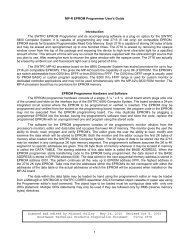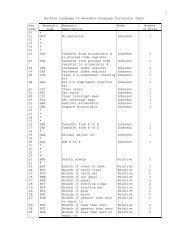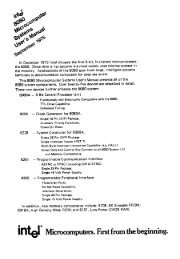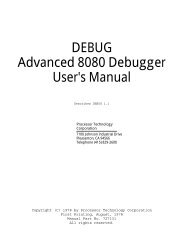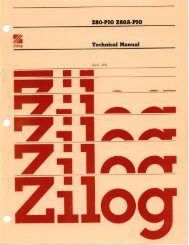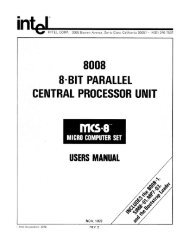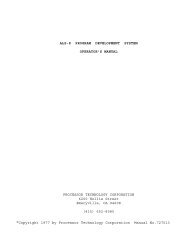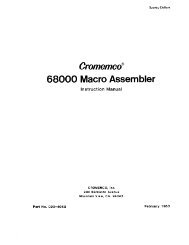The System Manual of SOL-20 - History of Computers
The System Manual of SOL-20 - History of Computers
The System Manual of SOL-20 - History of Computers
Create successful ePaper yourself
Turn your PDF publications into a flip-book with our unique Google optimized e-Paper software.
PROCESSOR TECHNOLOGY CORPORATION<br />
Sol THEORY OF OPERATION<br />
SECTION VIII<br />
Sol is normally configured with the D-to-E jumper installed<br />
to meet the clock requirements <strong>of</strong> the 8080A CPU. With this jumper<br />
installed, the outputs <strong>of</strong> the third and fourth U90 stages are applied<br />
to pins 9 and 10 <strong>of</strong> U91. Assuming U90 is reset to zero, pin 8 <strong>of</strong> U91<br />
is high, and on the first clock pulse the counter contents change to<br />
1000. (Refer to 2.045 MHz Clocks portion <strong>of</strong> Figure 8-1 on Page<br />
VIII-11.) Pin 8 <strong>of</strong> U91 cannot change until the fourth state (1111),<br />
at which time it goes to zero. On the fifth clock pulse the counter<br />
changes to 0111. Again, pin 8 <strong>of</strong> U91 cannot change from zero until<br />
one <strong>of</strong> its inputs changes. As shown in Figure 8-1, the third U90<br />
stage (C) changes on the seventh clock. <strong>The</strong> counter now stands at<br />
0001, and on the eighth clock the counter flips to 1000 and the count<br />
cycle repeats. <strong>The</strong> pattern is thus 1000, 1100, 1110, 1111, 0111,<br />
0011, 0001. U90 consequently goes through seven states. We have a<br />
3.5-stage counter that divides DOT CLOCK by seven to supply a 2.045<br />
MHz output.<br />
With no jumper installed, pin 10 <strong>of</strong> U91 is pulled high by<br />
R105, and U91 operates as a simple inverter for feeding back the<br />
output <strong>of</strong> the third U90 stage. In effect we have a three-stage counter<br />
that operates in a similar manner to that described in the preceding<br />
paragraph. It gees through six states (100, 110, 111, 011,<br />
001, 000) to divide DOT CLOCK by six which produces a 2.386 MHz output.<br />
<strong>The</strong> timing for this option is also shown in Figure 8-1.<br />
Let's now put the D-to-C jumper in. <strong>The</strong> feedback in this<br />
case is the NAND combination <strong>of</strong> the outputs from the second (B) and<br />
third (C) U90 stages. This gives us a 2.5-stage counter that divides<br />
DOT CLOCK by five. As can be determined from the 2.863 MHz portion<br />
<strong>of</strong> Figure 8-1, the counter has five states with this option, and the<br />
count pattern is: 100, 110, 111, 011, 001.<br />
Outputs from U90 are applied to the logic comprised <strong>of</strong> the<br />
remaining three sections in U91. This logic and the A-to-B jumper<br />
option permits extracting clock pulses <strong>of</strong> varying widths and relationships<br />
to each other from various points within the counter. We<br />
extract two clock signals: φ1 on pin 6 <strong>of</strong> U91 and φ2 on pin 11 <strong>of</strong><br />
U91. (<strong>The</strong> ability to select the frequency and pulse width for φ1 and<br />
φ2 permits the use <strong>of</strong> either the 8080A, 8080A-1 or 8080A-2 CPU for<br />
U105. <strong>The</strong> "A" version is the slowest speed unit, the "A-2" has<br />
an intermediate speed, and the "A-l" is the fastest.) Let's now<br />
see how the pulse width <strong>of</strong> φ1 and φ2 are determined.<br />
φ1 on pin 6 <strong>of</strong> NAND gate U91 is low only when its two inputs<br />
are high, and this happens only when there is a 1 in the second and<br />
fourth stages <strong>of</strong> U90. This occurs during the time between the fourth<br />
and sixth fundamental clocks for 2.04 MHz operation--the fourth and<br />
fifth clocks for 2.38 MHz and 2.86 MHz. Keeping in mind that the<br />
fundamental clock period is 70 nsec, it is readily seen that the low<br />
frequency pulse train on pin 6 <strong>of</strong> U91 has a pulse width <strong>of</strong> 140 nsec<br />
and the two higher frequency pulse trains have a pulse width <strong>of</strong> 70<br />
nsec. (Refer to Figure 8-1 on Page VIII-11.)<br />
VIII-9



